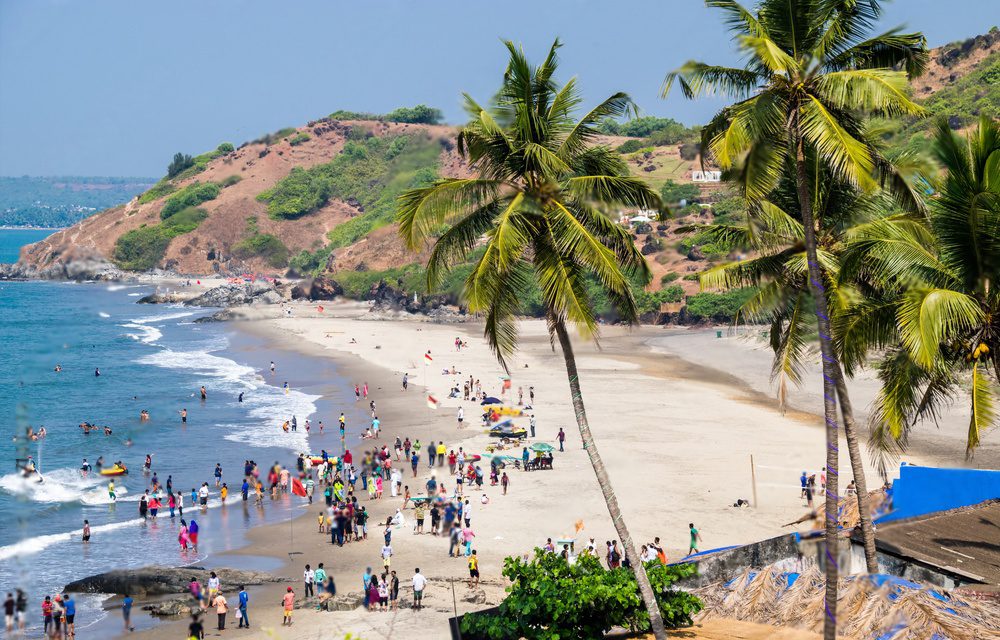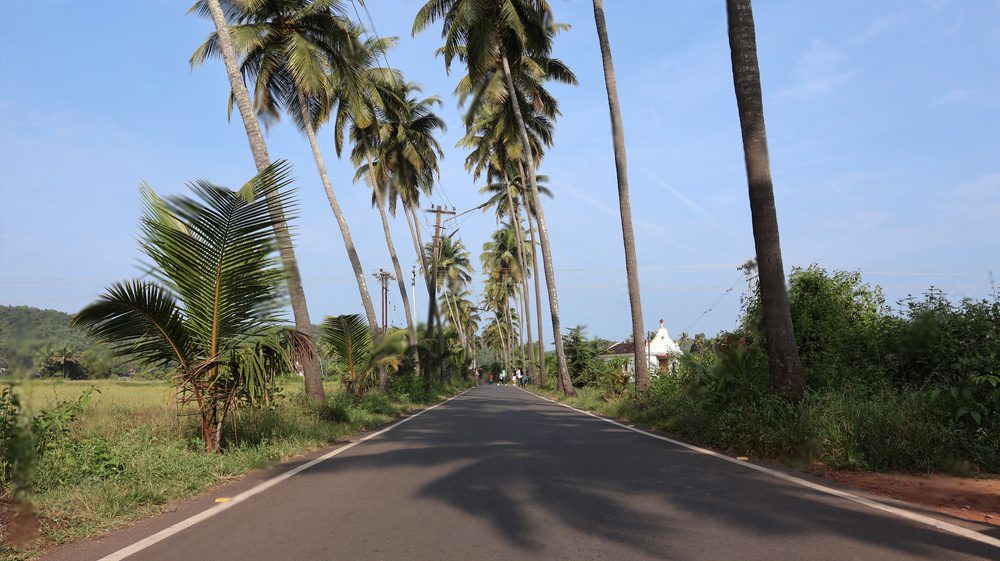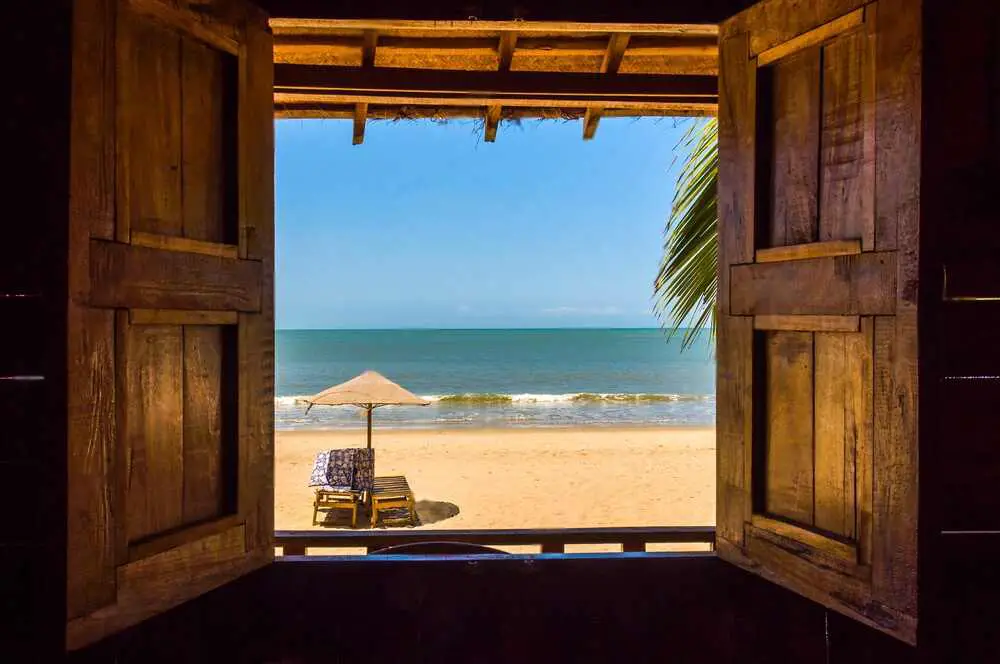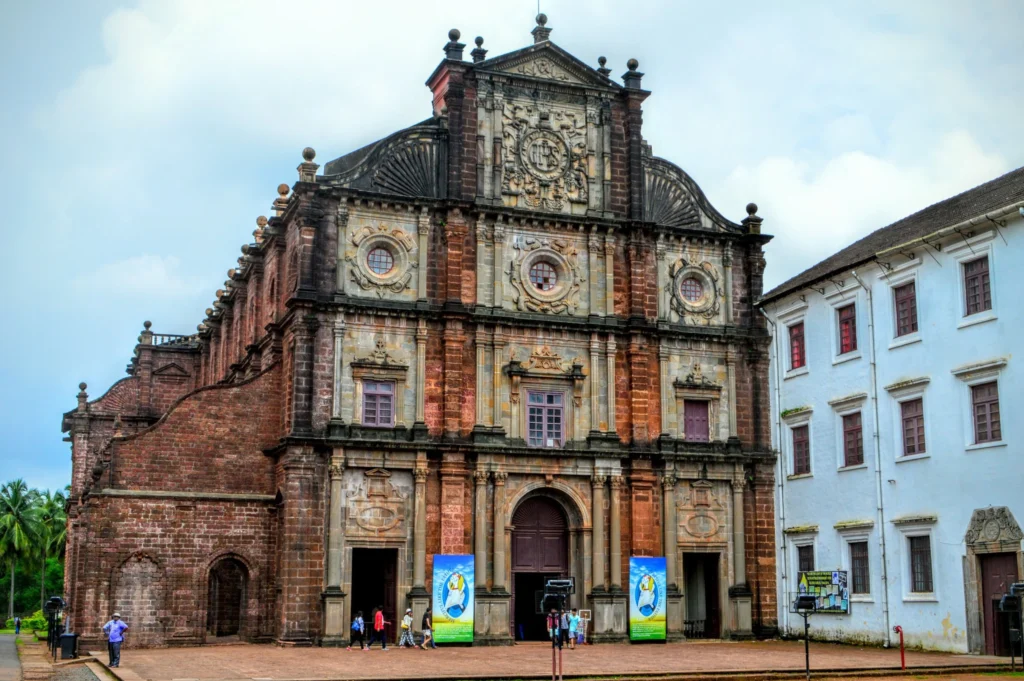Humayun’s Tomb is a beautiful building in the heart of Delhi. It was built in 1570 to honor Emperor Humayun, the second Mughal ruler of India. This grand building is made of red sandstone and has lovely marble decorations. It’s a perfect mix of Indian and Persian styles, making it a truly special place. This tomb is very important because it was one of the first of its kind in India. Many other beautiful buildings, like the famous Taj Mahal, were inspired by it. The tomb sits in a big garden with water channels, creating a peaceful atmosphere.
Visiting Humayun’s Tomb is like stepping back in time. It’s a wonderful way to learn about the rich history and culture of India.
How to reach:
Public Transport:
- Metro: The easiest way to reach Humayun’s Tomb is by Delhi Metro. Take the Violet Line and get off at JLN Stadium or Khilafat House stations. From there, you can take a short auto or taxi ride.
- Bus: Several Delhi Transport Corporation (DTC) buses, like numbers 171, 103, and 201, pass near the tomb. Check bus routes for the best option based on your starting point.
- Taxi or Auto-rickshaw: You can easily find taxis or auto-rickshaws in Delhi. Use ride-hailing apps or hail one on the street.
- Car: Humayun’s Tomb is located on Nizamuddin East Road. There’s parking nearby. Use a GPS for directions.
- Bicycle: Delhi has bike rental services. Cycling to the tomb can be a pleasant way to explore the city.
- Walking: If you’re staying nearby, walking to the tomb is a good option.
Best time to visit:
Winter (October to March)
This is the most pleasant time to visit Humayun’s Tomb. The weather is cool and comfortable, perfect for exploring the monument and its gardens. Clear skies make it ideal for photography.
Summer (April to June)
Summers in Delhi are very hot. Visiting Humayun’s Tomb during this time can be uncomfortable. If you do visit, go early in the morning or late in the afternoon. Remember to stay hydrated and wear sunscreen.
Monsoon (July to September)
Delhi experiences heavy rain during the monsoon season. While it can be cooler, the weather is humid and the site can be muddy. Be prepared for rain and carry an umbrella.
Post-Monsoon (September to October)
The weather starts to improve after the monsoon. It’s less humid and the gardens are green. This is a good time to visit before the winter crowds arrive.
Attractions:
The Main Tomb:
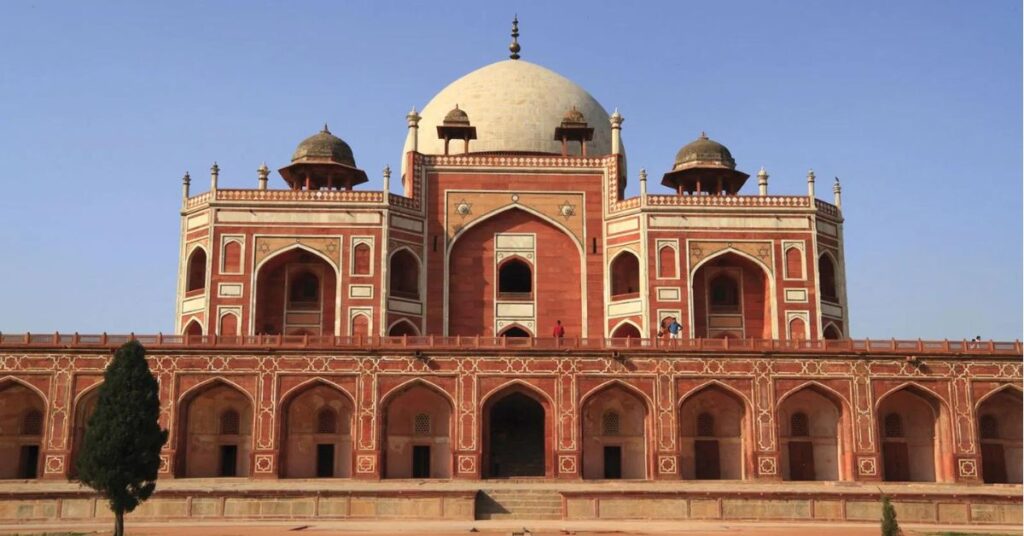

The centerpiece of Humayun’s Tomb is its amazing main building. It’s made of beautiful red stone and white marble, and has a tall, round dome. The dome is covered in pretty patterns and carvings, showing how skilled the artists were. The whole building is very symmetrical and looks elegant. It’s like a smaller, earlier version of the famous Taj Mahal.
The Gardens:
Humayun’s Tomb sits in a beautiful garden called a Charbagh. It’s divided into four equal parts by water channels, like the rivers in heaven. The garden is full of green plants, fountains, and still pools of water. It’s a peaceful place to relax and enjoy the beauty of nature. The way the garden is designed, with paths, water, and plants, shows how much the Mughals loved nature and wanted to create a perfect space.
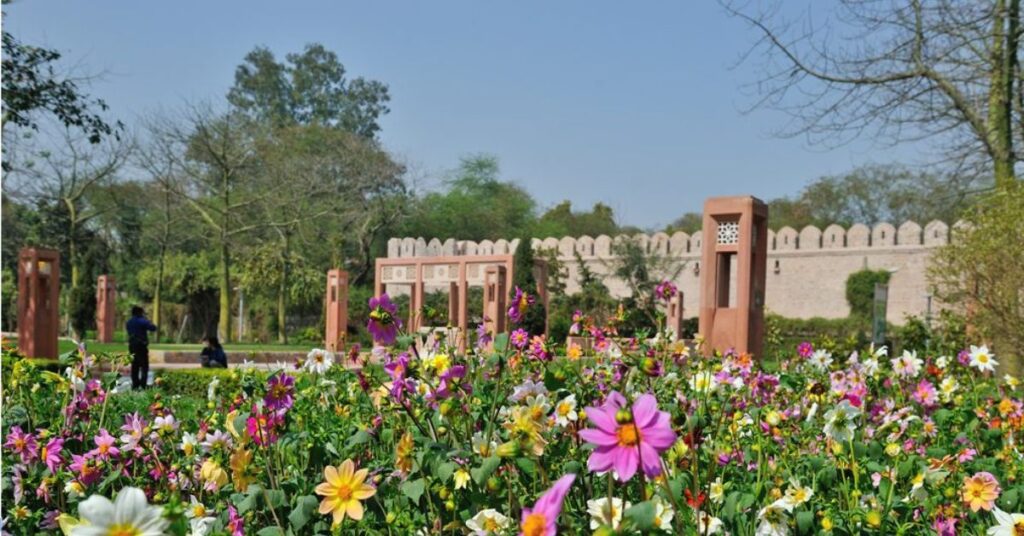

The Entrance Gate (Nadira Begum’s Gateway):
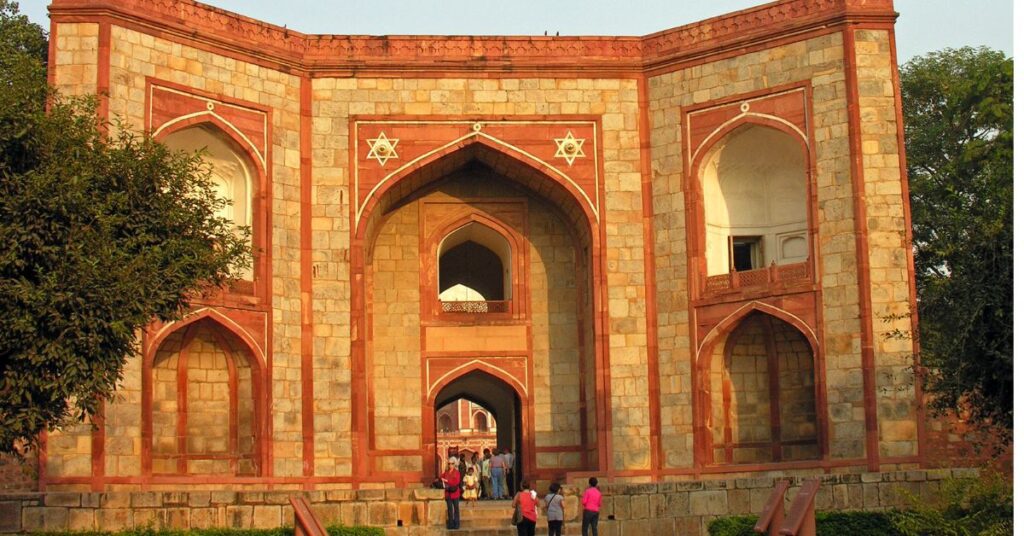

The entrance to Humayun’s Tomb is really impressive. It’s called Nadira Begum’s Gateway and it’s a big, beautiful gate with fancy arches and carvings. This grand gate gives you a hint of the amazing things you’ll see inside. The gate is covered in beautiful patterns and writing that show how talented the Mughal artists were. As you walk through this stunning entrance, you can’t help but feel excited about exploring the rest of the tomb.
The Barber’s Tomb:
Right next to Humayun’s grand tomb is a smaller but still important building. It’s the tomb of Humayun’s barber. This smaller building looks a lot like the main tomb, with the same red stone and white marble. It’s interesting because it shows how important even the less famous people around the emperor were. The barber’s tomb tells us about how much respect the Mughal rulers had for everyone who served them.
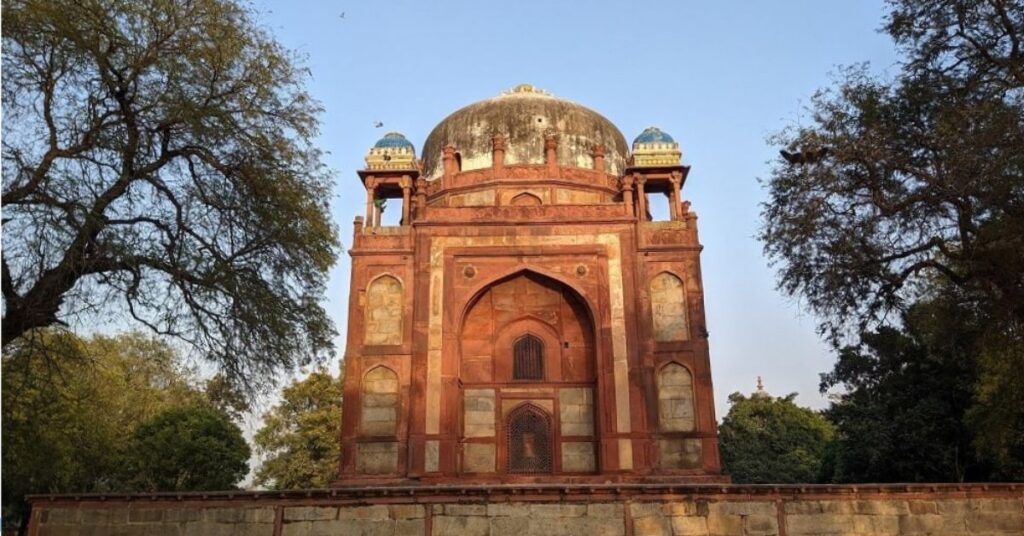

Local Experiences:
- Guided Tours: Learn about the tomb’s history and architecture from knowledgeable guides.
- Photography: Capture the beauty of the tomb and gardens.
- Explore Nearby: Visit other historical sites like Isa Khan’s Tomb and the Barber’s Tomb.
- Walking Tour: Enjoy a peaceful walk through the beautiful gardens.
- Taste Local Food: Try delicious local dishes at nearby eateries.
- Attend Events: Check for cultural events and festivals in the area.
- Picnic: Relax and enjoy a picnic in the gardens.
- Shop Local: Find unique souvenirs at nearby craft shops.
- Birdwatching: Spot different bird species in the gardens.
- Relax and Meditate: Find peace and quiet in the serene surroundings.
- Meet Locals: Chat with locals to learn about the area’s history and culture.
- Historical Walks: Join a guided walk to learn more about the Mughal era.
Travel tips:
- Timing is Key: Arrive early in the morning to beat the crowds and enjoy better lighting for photos.
- Dress Comfortably: Wear comfortable clothes and shoes. Dress respectfully, as this is a historical site.
- Essentials: Bring water, sunscreen, a hat, and sunglasses for sun protection. A light jacket might be needed in cooler months.
- Check Details: Confirm the tomb’s opening hours and any potential closures before your visit.
- Respectful Behavior: Follow the site’s rules. Don’t touch artifacts or climb on the monument.
- Stay Hydrated: Drink plenty of water, especially in warmer weather.
- Transportation: Use public transport like the Delhi Metro to avoid traffic and parking.
- Security: Carry ID and be ready for security checks. Large bags might be restricted.
- Enhance Your Visit: Consider hiring a guide for a deeper understanding of the tomb.
- Avoid Crowds: Visit on weekdays if possible, or come early or late in the day.
- Practical Tips: Bring some cash, as not all vendors accept cards. Check photography rules before snapping pictures.
Conclusion
Humayun’s Tomb, a majestic testament to Mughal architectural brilliance, offers a serene escape into Delhi’s historical heart. This UNESCO World Heritage site, with its intricate design, sprawling gardens, and the grandeur of the main mausoleum, provides a captivating glimpse into the Mughal Empire’s splendor. Explore its architectural marvels, immerse yourself in its rich history, or simply seek tranquility amidst the bustling city; Humayun’s Tomb promises a memorable experience. Plan your visit with Xplro.com to discover this architectural gem and delve into Delhi’s cultural tapestry.
FAQs
1. What is Humayun’s Tomb?
- Humayun’s Tomb is a prominent Mughal mausoleum located in Delhi, India. It was constructed in 1570 by Empress Bega Begum to honor her late husband, Emperor Humayun. This tomb is a key example of Mughal architecture and is listed as a UNESCO World Heritage Site.
2. What are the visiting hours for Humayun’s Tomb?
- Humayun’s Tomb is open from sunrise to sunset. To avoid any surprises, it’s a good idea to confirm the exact opening hours and check for any scheduled closures or maintenance before planning your visit.
3. How much is the entry fee to Humayun’s Tomb?
- The entry fee is approximately ₹40 for Indian citizens and around ₹600 for foreign visitors. There may be additional charges for photography and videography. It’s wise to verify the latest fees at the entrance or on the official website.
4. How can I reach Humayun’s Tomb?
- Humayun’s Tomb is easily accessible by Delhi Metro, taxi, auto-rickshaw, or bus. You can alight at the JLN Stadium or Khilafat House metro stations and take a short ride to the site.
5. Is there a dress code for visiting Humayun’s Tomb?
- While there is no formal dress code, visitors are encouraged to dress modestly as a mark of respect. Comfortable clothing and walking shoes are advisable for a pleasant visit.
6. Can I take photographs at Humayun’s Tomb?
- Photography is generally permitted, but some restrictions may apply in specific areas. Flash photography inside the tomb might be restricted, so be sure to follow the guidelines provided at the entrance.
7. Are guided tours available at Humayun’s Tomb?
- Yes, guided tours are available and can provide detailed information about the tomb’s history, architecture, and cultural significance. Guides can often be hired at the entrance or booked in advance.
8. What is the best time to visit Humayun’s Tomb?
- The ideal time to visit is from October to March, when the weather is cooler and more comfortable for exploring the tomb and its gardens.
9. Are there dining options near Humayun’s Tomb?
- There are several dining options in the nearby Nizamuddin area. You can enjoy a variety of local Delhi dishes and snacks at nearby restaurants and street food vendors.
10. Can I bring food and drinks into Humayun’s Tomb?
- Food and drinks are typically not allowed inside the tomb complex. It’s best to consume any refreshments before or after your visit and use designated areas if available.
11. Is there parking available at Humayun’s Tomb?
- Yes, parking is available near the tomb’s entrance. However, it can be quite crowded, especially during peak times. Consider using public transport or ride-sharing services for convenience.
12. Are there facilities for visitors at Humayun’s Tomb?
- Basic amenities such as restrooms and a visitor center are available. There are also ticket counters and areas for purchasing souvenirs. Check the site for any additional services or facilities offered.
